| Home | Nature Weekly Index |
20 October 2024 | Field Trips | TreeTop Walk Trail |
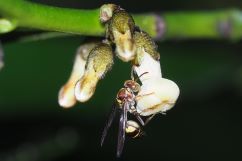 |
| Fig. 1: Flower and buds of Diospyros oblonga |
Since August, it has become a routine for me to make at least a field trip in a week. I had intentionally targeted the same route each week unless there were more important observations that I needed to attend to in other locations. The route targeted was the TreeTop Walk trail. That was the reason for the many notes in the past months on my observations on this trail.
The regular trips to the same locations had enable me to monitor some plants over time, especially those that were flowering. One of them was Diospyros oblonga. Its flower buds were first observed on 12 September. A few of the buds bloomed on 27 September (Fig 1). Unfortunately, all the flowers were gone on 10 October. I was hopping to see the fruit but no luck this time round. The wasp that visited the flower should be Ropalidia mathematica.
Of the few other plants that I had been monitoring, 2 of them were Syzygium species. While I might reasonably guess their genus, I was not able to narrow them to their species names for now.
| 10 October 2024 | 27 September 2024 | 12 September 2024 |
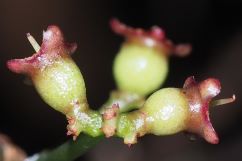 |
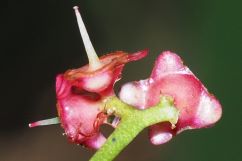 |
 |
| Fig. 2: Syzygium species 1 | ||
Syzygium species 1 (Fig 2): This species was first observed on 12 September. While there were more than 10 flowers seen, most of them eventually dropped off. In the last visit on 10 October, only 3 young fruits were left. Hopefully, they would hang on till their maturity.
Syzygium species 2 (Fig 3): The overall appearance of this tree and leaves looked very similar to that of Syzygium grande (Sea Apple). It was only noticed when its flower buds started to appear in bundles on 12 September. Even so, I had not paid too much attention to it as I thought it was a Sea Apple tree which was a rather common tree. The view changed when the flowers started to bloom. They were too small compared to that from the Sea Apple tree.
 |
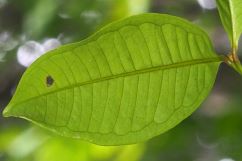 |
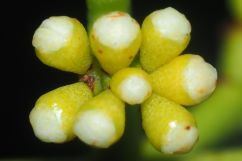 |
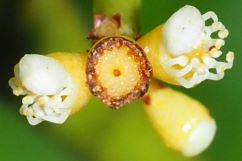 |
| Fig. 3: Syzygium species 2 | |||
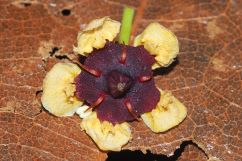 |
| Fig. 4: Fallen flower of Lophopetalum wightianum on the ground |
Besides the 2 Syzygium species, I was also checking on the Lophopetalum wightianum tree regularly. Its fruits were first seen on the ground on 22 August. Thereafter, I no longer saw any fresh fruits on the ground in subsequent trips. On 2 October, I started to see many of its flowers littering the ground (Fig. 4). Many fresh flowers were still seen on the ground when I last visited the location last week.
| Table 1: Date and time of visits to TreeTop Walk trail | |||||
| Date | Start | End | Date | Start | End |
|---|---|---|---|---|---|
| 15 August | 8:18 AM | 1:45 PM | 27 September | 8:27 AM | 1:05 PM |
| 22 August | 8:26 AM | 1:57 PM | 2 October | 8:22 AM | 12:46 PM |
| 12 September | 8:19 AM | 1:19 PM | 10 October | 8:30 AM | 11:16 AM |
| 18 September | 8:32 AM | 1:30 PM | 17 October | 8:16 AM | 10:40 AM |
As my daily routine had changed since July, I was now able to plan my field trip during weekdays. This made a huge difference to me compared to having to visit the trails during weekends in the past where the human traffic was very heavy. Up till today, I had made 8 trips to the TreeTop Walk trail. I was blessed with good weather for 6 out of the 8 trips (Table 1); the last two trips was met with heavy rain near the end of the walk and thus the earlier end time. The start and end time in the table were based on the first and last picture snapped.
From this post onward, I would be adding captions to the images and referencing to them within the text of the post. This would provide better clarity on the relevant images that I was referring to in my post.
Update: 3 November 2024
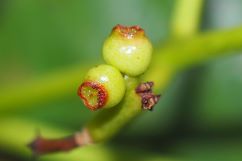 |
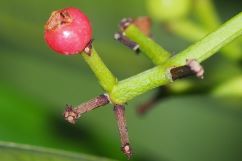 |
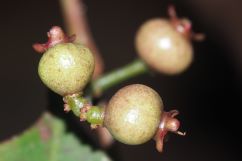 |
| Immatured and matured fruits of Syzygium pustulatum | Immatured fruits of Syzygium species 1 | |
During my most recent visit on 29 October, I noted that there were very few fruits remaining on the tree of Syzygium species 2. The small, mature fruits displayed a red colour. Based on this observation, I identified the tree as Syzygium pustulatum. This was the second specimen I had encountered; the first one was observed in a park near my residence in 2014, although that tree has since been removed. Regarding Syzygium species 1, the three fruits remained intact, but I doubt they had reached maturity.